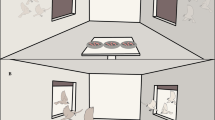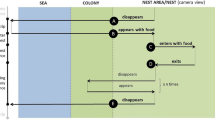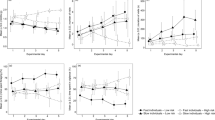Abstract
Although there are several possible advantages of flocking1–3, many authors suggest that birds forage in groups to reduce the risk of predation (see citations in ref. 4). One version of the ‘many eyes’ hypothesis proposes that flocking allows individuals to spend less time scanning for predators and more time feeding5,6. However, flocking may also cause individuals to lose time and energy in fighting one another. The way a bird divides its time among these activities, its time budget, may depend on variables governing foraging requirements and the chance of predation7. As one such variable is the frequency of attacks by predators8, we flew a trained hawk over flocks of granivorous yellow-eyed juncos (Junco phaeonotus) to compare time budgets in the presence and absence of a predator. We found that time budgets changed after the predator was introduced and also that flock size increased in the presence of the predator.
This is a preview of subscription content, access via your institution
Access options
Subscribe to this journal
Receive 51 print issues and online access
$199.00 per year
only $3.90 per issue
Buy this article
- Purchase on Springer Link
- Instant access to full article PDF
Prices may be subject to local taxes which are calculated during checkout
Similar content being viewed by others
References
Brown, J. L. Am. Zool. 14, 51–62 (1974).
Cody, M. L. Theor. Popul. Biol. 4, 142–158 (1971).
Krebs, J. R. Behaviour 51, 99–134 (1974).
Treisman, M. Anim. Behav. 23, 779–800 (1975).
Pulliam, H. R. J. theor. Biol. 38, 419–422 (1973).
Siegfried, W. R. & Underbill, L. R. Anim. Behav. 23, 504–508 (1975).
Caraco, T. Ecology 60, 618–627 (1979).
Caraco, T. Ecology 60, 611–617 (1979).
Pulliam, H. R. in Perspectives in Ethology (eds Klopfer, P. H. & Bateson, P. G.) 311–332 (Plenum, New York, 1976).
Hamilton, W. D. J. theor. Biol. 31, 295–311 (1971).
Kenward, R. E. J. Anim. Ecol. 47, 449–460 (1978).
Author information
Authors and Affiliations
Rights and permissions
About this article
Cite this article
Caraco, T., Martindale, S. & Pulliam, H. Avian flocking in the presence of a predator. Nature 285, 400–401 (1980). https://doi.org/10.1038/285400a0
Received:
Accepted:
Issue Date:
DOI: https://doi.org/10.1038/285400a0
This article is cited by
-
Predator attack patterns influence vigilance in a virtual experiment
Behavioral Ecology and Sociobiology (2020)
-
The influence of a single species on the space use of mixed-species flocks in Amazonian Peru
Movement Ecology (2019)
-
Investigating responses to control: a comparison of common myna behaviour across areas of high and low trapping pressure
Biological Invasions (2018)
-
The structure of mixed-species bird flocks, and their response to anthropogenic disturbance, with special reference to East Asia
Avian Research (2015)
-
Predation-risk effects of predator identity on the foraging behaviors of frugivorous bats
Oecologia (2013)
Comments
By submitting a comment you agree to abide by our Terms and Community Guidelines. If you find something abusive or that does not comply with our terms or guidelines please flag it as inappropriate.



